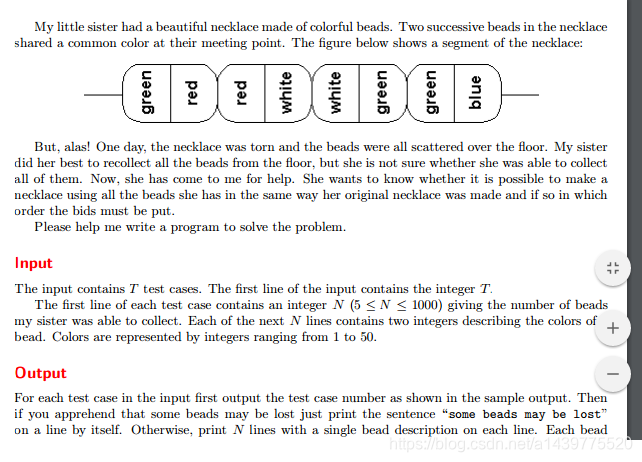
中文翻译:
但是,唉!一天,项链被撕破了,珠子散落在屋檐上。我姐姐尽力把地板上的珠子都捡起来了。但她不确定自己是否能收集到所有的照片。现在,她来找我帮忙。她想知道是否有可能让克劳斯使用她在里面的所有珠子,请帮助我写一个程序来解决这个问题。输入这个输入包含t’测试用例。输入的第一行包含整数。bead的数目每个测试用例的第一行包含一个整数n(5<n 1000),因为我妹妹可以收集。接下来的n行中的每一行都包含两个描述珠子颜色的整数。颜色由从1到50的整数表示,对于输入中的每个测试用例,首先输出示例输出中显示的测试用例编号。如果你觉得有些珠子可能会丢失,那就打印出来,这些珠子本身可能会丢失。否则,在每行上打印n行,并使用单珠说明。每个珠在一条线上。否则,在每行上打印n行,并使用单珠说明。每个beadDescription由两个整数组成,给出其两端的颜色。对于1<i<n1,第二行整数i必须与linn上的第一个整数相同,并且必须等于第1行上的第一个整数。由于有许多解决方案,因此其中任何一个都是可接受的,在两个连续的测试用例之间打印一个空白行s25le22356522233示例输出
package com.liuzhen.practice;
import java.util.ArrayList;
import java.util.Scanner;
public class Main {
public static int MAX = 1000;
public static int start, count;
public static int num = 0;
public static int[] id = new int[MAX];
public static int[] degree = new int[MAX]; //用于计算给定图每个顶点的度
public static boolean[] used = new boolean[MAX]; //用于判断图中相应边是否被遍历
public static String[] path = new String[MAX];
public static ArrayList<String> result = new ArrayList<String>();
static class edge {
public int a; //边的起点
public int b; //边的终点
public int num; //边的编号
public edge(int a, int b, int num) {
this.a = a;
this.b = b;
this.num = num;
}
public String getAB() {
return a + " "+ b;
}
}
//寻找顶点a的根节点
public int find(int[] id, int a) {
int root = a;
while(id[root] >= 0) {
root = id[root];
}
int i;
int k = a;
while(k != root) {
i = id[k];
id[k] = root;
k = i;
}
return root;
}
//合并顶点a和顶点b所在的树
public void union(int[] id, int a, int b) {
int rootA = find(id, a);
int rootB = find(id, b);
if(rootA == rootB)
return;
int rootNum = id[rootA] + id[rootB];
if(id[rootA] < id[rootB]) {
id[rootB] = rootA;
id[rootA] = rootNum;
} else{
id[rootA] = rootB;
id[rootB] = rootNum;
}
return;
}
public void init() {
count = 0;
for(int i = 0;i < 51;i++) {
id[i] = -1; //初始化所有顶点所在树的根节点编号为-1
degree[i] = 0;
}
for(int i = 0;i < MAX;i++) {
used[i] = false;
path[i] = "";
}
return;
}
public boolean judge(ArrayList<edge>[] map) {
int root = find(id, start);
for(int i = 0;i < map.length;i++) {
for(int j = 0;j < map[i].size();j++) {
if(root != find(id, map[i].get(j).b))
return false;
}
}
for(int i = 0;i < degree.length;i++) {
if(degree[i] % 2 != 0)
return false;
}
return true;
}
public void dfs(ArrayList<edge>[] map, int start) {
for(int i = 0;i < map[start].size();i++) {
if(!used[map[start].get(i).num]) {
used[map[start].get(i).num] = true;
path[count++] = map[start].get(i).getAB();
dfs(map, map[start].get(i).b);
}
}
}
public static void main(String[] args) {
Main test = new Main();
Scanner in = new Scanner(System.in);
int t = in.nextInt(); //总共要输入的图的数目
while(t > 0) {
t--;
@SuppressWarnings("unchecked")
ArrayList<edge>[] map = new ArrayList[51];
for(int i = 0;i < 51;i++)
map[i] = new ArrayList<edge>();
int k = in.nextInt(); //一次输入图的边数目
test.init();
for(int i = 0;i < k;i++) {
int a = in.nextInt();
int b = in.nextInt();
map[a].add(new edge(a, b, num));
map[b].add(new edge(b, a, num++));
degree[a]++;
degree[b]++;
test.union(id, a, b);
start = a;
}
String temp = "";
if(test.judge(map)) {
test.dfs(map, start);
for(int i = 0;i < k;i++) {
temp = temp + path[i] + "
";
}
} else {
temp = "some beads may be lost";
}
result.add(temp);
}
for(int i = 0;i < result.size();i++) {
System.out.println("Case #"+(i+1));
System.out.println(result.get(i)+"
");
}
}
}
运行结果:
5
2
3
4
5
6
2 1
2
4
1
4
Case #1
some beads may be lost
Case #2
1
3
4
2
2